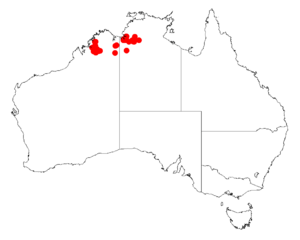Acacia froggattii facts for kids
Quick facts for kids Acacia froggattii |
|
|---|---|
| Scientific classification | |
| Genus: |
Acacia
|
| Species: |
froggattii
|
 |
|
| Occurrence data from AVH | |
Acacia froggattii is a type of shrub, also known as a wattle, that belongs to the Acacia plant family. It is special because it only grows in certain parts of northwestern Australia. This means it is an endemic species, found nowhere else in the world.
What Does Froggatt's Wattle Look Like?
This wattle is a thick, sticky shrub. It usually grows to be about 0.45 to 1 meter (1.5 to 3.3 feet) tall. Its branches are round and covered in tiny hairs. It also has small, needle-shaped parts called stipules, which are about 1 to 1.5 millimeters long and stay on the plant.
Like most Acacia species, it doesn't have true leaves. Instead, it has special flattened stems called phyllodes that act like leaves. These phyllodes are packed closely together and point upwards. They can be wedge-shaped, oval, or elliptic. Each one is about 3.5 to 7 millimeters long and 1.2 to 2.5 millimeters wide. The phyllodes feel leathery and have tiny hairs. They also have three faint lines, or nerves, on them.
Froggatt's Wattle blooms from July to November. During this time, it produces bright yellow flowers.
How Was Froggatt's Wattle Named?
The first official description of Acacia froggattii was made by a botanist named Joseph Maiden. He described it in 1920. This description was part of his work called Notes on Acacias, No. IV, with descriptions of new species. This work was published in a scientific journal.
Later, in 1987, another botanist named Leslie Pedley reclassified it. He moved it to a different group called Racosperma froggattii. However, in 2001, it was moved back to the Acacia group. So, its scientific name is now Acacia froggattii again.
Where Does Froggatt's Wattle Grow?
This wattle is found naturally in two main areas of Australia. It grows in the Northern Territory and the Kimberley region of Western Australia.
You can often find it on hillsides and among rocky areas. It prefers to grow in gravelly, thin soils. These soils are usually found in places with quartzite and sandstone rocks. The plant's range stretches across rugged hills. These include the Isdell Range, Artesian Range, and Phillips Ranges in Western Australia. It also grows in the Fitzroy Range in the Northern Territory. Here, it is part of shrubland and open woodland plant communities.

